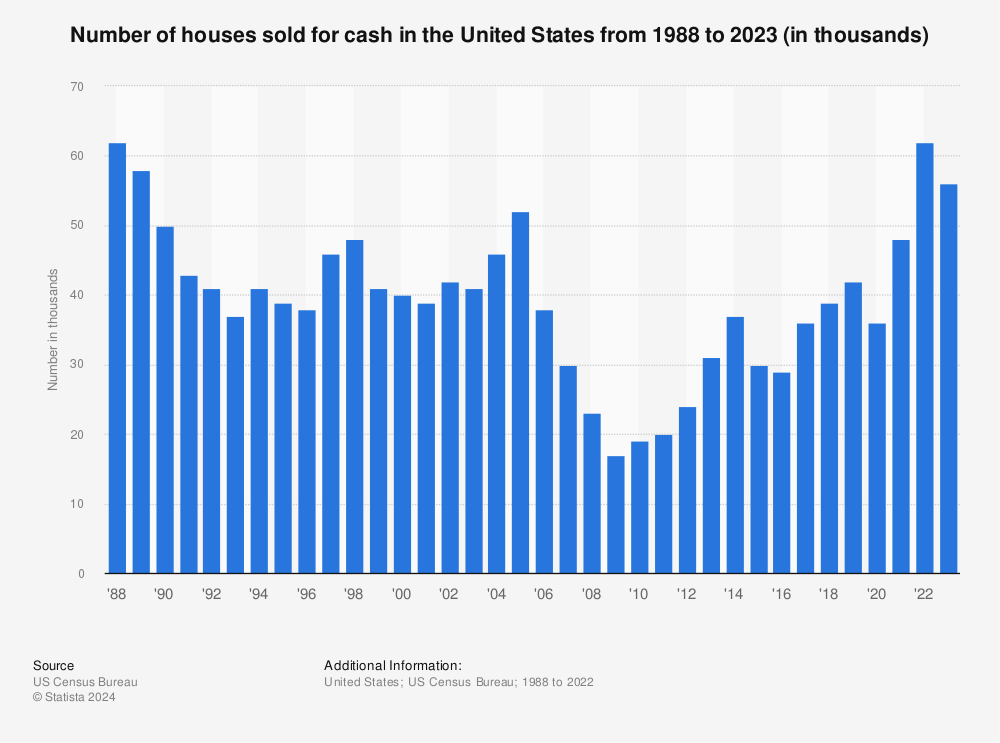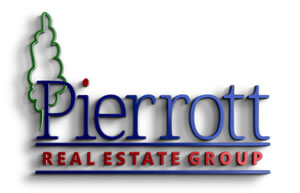Among your family and friends, you may not know anyone who paid all-cash for a house. So what percentage of homebuyers pay cash, and how likely are you to receive a cash offer if you sell your home?
It varies by individual market, but cash sales trended upward in 2021 due to a low supply of homes, bevy of demand, and increase in well-funded fintech players purchasing homes nationwide, according to a report from the National Association of Realtors (NAR).
In April 2021, cash sales represented 25% of existing home sales, a level unmatched since 2016, and had only cooled slightly to 23% as of July. Top-selling Las Vegas real estate agent Rick Ruiz reports that buyers paid cash for almost 15% of the homes he sold so far in 2021. He expects that percentage to continue to grow.
Despite the rapid rise in home prices to a median price of $352,000, buyers have been more eager to pay cash or find a cash solution in order to make their offer stand out. Many sellers prefer to accept all-cash to avoid the possibility of financing delays and reduce the chances of an offer falling through — hence the notion that “cash is king.”

Historical effect of economics on the cash real estate market
The number of homes sold for cash tends to rise and fall in line with other economic patterns. Data from the U.S. Census Bureau on the number of new single family homes that sold for cash from 1988 to 2020 shows that cash sales are more likely to occur during a property boom and then retreat during a downturn.

Find more statistics at Statista
For example, during the property boom of the late 1980s, as many as 62,000 new single family homes sold for cash during the year of ‘88. That number dropped to 37,000 in the brief early 1990s recession. A similar trend emerged in the 2000s — cash sales jumped to 52,000 in 2005 before falling to 17,000 in 2009 in the aftermath of the Great Recession.
In essence, a strong jobs market gives more buyers the ability to pay for a house with cash, and when housing demand surges, cash purchases may rise in response to a more competitive market. When markets cool, housing often becomes less competitive and people may prefer to save their money in the face of financial instability.
Factors affecting the percentage of cash buyers in a market
What percentage of homebuyers pay cash in your city will depend on variables including housing supply levels and the popularity of your location. The desirability of your individual property and whether you’re able to rouse a bidding war can also impact whether you attract a cash offer.
And you also have to consider the types of buyers in your area. Are they supported by familial wealth or cash from a previously owned property? Or are they mostly first-timers who will likely use financing to make their purchase? Do you have a number of active iBuyers (instant buyers) in the area who purchase homes with cash?
Let’s review these factors in further detail and how they may impact your ability to generate a cash offer on your home.
1. Location, climate, and affordability
Some markets have seen a recent influx of cash offers driven by remote workers relocating from expensive to relatively affordable cities. These buyers use the proceeds from the sale of their previous (and often pricey) home to pay all-cash in a cheaper market.
This trend has been seen prominently in the state of Florida where the percentage of cash sales in cities such as Naples and West Palm beach exceeded 50% in 2021.
Due to their fantastic weather, Sun Belt markets are often popular among investors or people buying second homes for vacation or retirement, making them cash-heavy. More than half of those who buy second homes pay with all-cash, according to NAR.
In contrast, you may not see the same volume of cash buyers in certain areas of California due to the exorbitantly high price of housing. While cash sales skyrocket in the Sunshine state, they’ve been lower than average in markets like San Francisco where 17.8% of sales were all-cash as of July 2021.
2. Wealth of local buyer pool
The pandemic spurred some unusual migration patterns, skewing cash sales higher in areas with more affordable housing as workers concentrated in particular cities suddenly spread out. But luxury homes in expensive areas may still easily sell for cash given the wealth-levels of the buyers who can afford them.
A report from Business Insider notes that the wealthiest millennials tend to be concentrated across 10 states, nine of which are coastal. Since millennials make up today’s largest pool of home buyers, luxury homes in places like California (hello, Silicon Valley), New York, and Massachusetts may appeal to this demographic. They are looking for spacious alternatives to their city dwellings, and they can bring cash to the table.
The prevalence of familial and stock market wealth may also impact how likely buyers are to pay cash in a given market. In a recent year-end HomeLight study, almost half of real estate agents surveyed reported their clients tapped into money from other family members to fund a house purchase. Another 37% of agents in the same study have clients that liquidated recent stock gains to pay for a house.
3. High volume of investment activity
Even with an increase in cash being paid for houses, 87% of individual buyers still require financing and cannot outright pay all cash. On the other hand, investors, which include house flippers, buy-and-hold investors, and iBuyers, almost always pay cash. It’s business rather than pleasure for these cash buyers.
House flippers
You are more likely to receive a cash offer from a house flipper in certain cities with housing stock that matches preferred house flipper parameters. To get an idea of where these locations are, WalletHub’s recent study ranks the best cities for home flippers to buy and sell properties.
If you live in one of these areas, such as Missoula, Montana; Boise, Idaho; or Mobile, Alabama; you may have an easier time getting a cash offer for your property.
A house flipper or home-buying company also may offer cash for your house if you live in a city where a large percentage of houses are affordable compared to the rest of the country and need renovations. Cleveland, Ohio, is a perfect example.
“Cleveland is an investor-heavy city,” shares Daniel Sarao of Sesa Properties. “Since Northeastern and California coastal housing markets are getting more expensive, investors are coming to the Midwest where prices are lower and they can manage to pay cash.”
Investors are attracted to these types of cities that afford them the opportunity to buy for 50% to 70% of market value. They then flip the house for a profit after they complete renovations or sometimes keep it and rent it out.
Buy-and-hold investors
These types of investors buy, renovate, and keep the properties for a longer time period than house flippers. They look for houses in neighborhoods that will provide long-term cash flow in the form of rental income for many years post-renovation.
In today’s pandemic-spurred flight to the suburbs, long-term real estate investors are interested in suburban homes in the Midwest, including Cleveland, Cincinnati, and Kansas City. A location with good school districts, proximity to major employers, or a nearby university are all factors that can make your house more appealing to a rental investor.
iBuyers
IBuyers have only been in existence since the mid-2010s, but they are essentially high-tech home buying businesses that provide near-instant cash offers on homes while providing a mostly online home-selling experience. They typically prefer to buy newer properties that are less likely to need major repairs and aren’t too expensive; the median price of a home purchase by an iBuyer was $350,000 in 2021.
You may see a higher amount of cash offers from an iBuyer in certain large metro areas with homogenous housing stock. Those cities that currently top the list for today’s iBuyers include Atlanta, Phoenix, Dallas-Fort Worth, Charlotte, and Raleigh.
5. International buyer activity
As of 2021, a substantial 39% of international buyers pay cash when they purchase a U.S. home, according to a report from NAR. Still, international buyers only account for 1.8% of all existing home sales, and the percentage of international buyers purchasing U.S. homes has decreased in recent years. When international buyers do purchase real estate in America, they tend to prioritize big cities including New York, San Francisco, Miami, Boston, Los Angeles, and Washington, D.C.
6. Concentration of repeat buyers
If you’re in a market with a lot of first-time buyers, it may be less likely that you’ll see a cash offer. For many first-time buyers, it’s a challenge to piece together a down payment, let alone pay for a home entirely in cash, unless they have familial help or another source of funds. However, markets with more retirees or trade-up buyers may see a higher volume of cash offers. Unlike first-timers, repeat buyers can draw on the funds of their existing homes to put toward the purchase of their next residence.

How to get a cash offer for your home
As of 2021, your odds of selling a house for cash stand at 23%, but that may go down in less competitive housing conditions. And as we’ve detailed here, some markets are more cash-heavy than others due to the concentration of vacation homes, affordability levels compared to where buyers are migrating from, and types of buyers likely to purchase homes in a particular area.
However, if you are set on receiving a full cash offer for your home, you can request one directly. If you seek a cash offer for certainty, speed, and convenience, consider HomeLight’s Simple Sale platform.
With Simple Sale, HomeLight provides all-cash offers for homes in almost any condition. You won’t have to worry about repairs, prep work, and open houses and will receive a cash offer for your house “as is.” Get started today, or try your hand at getting an offer the traditional way with the assistance of a top local real estate agent.
Header Image Source: (Lukasz Radziejewski / Unsplash)

